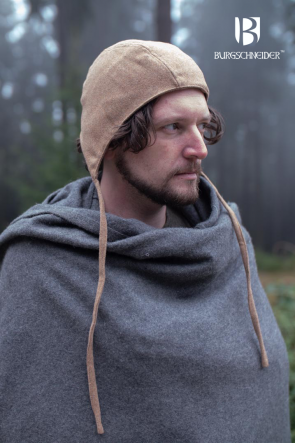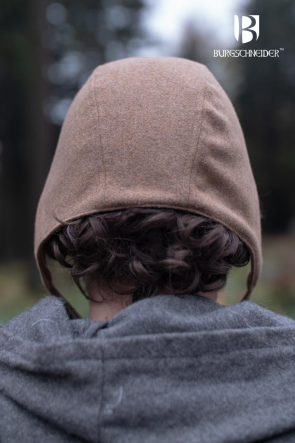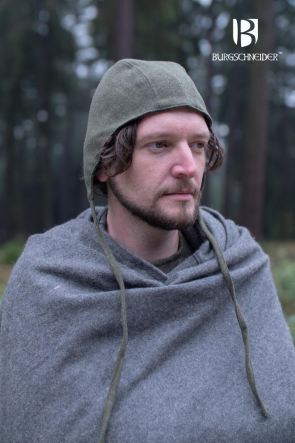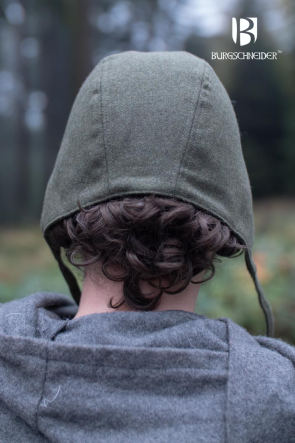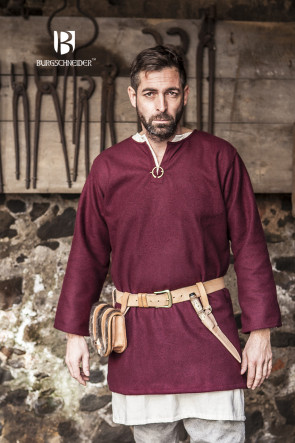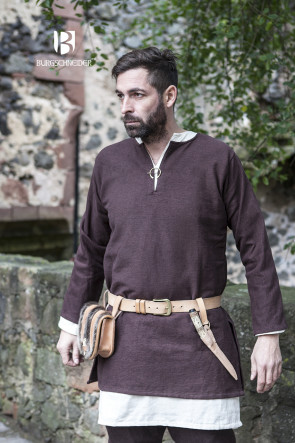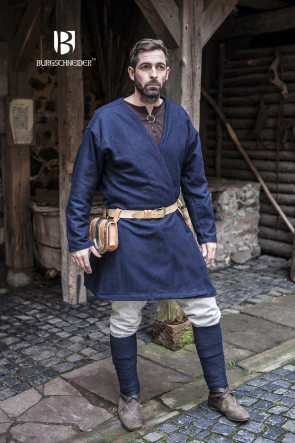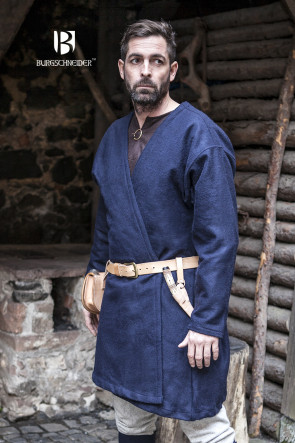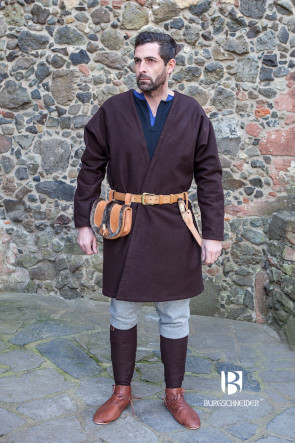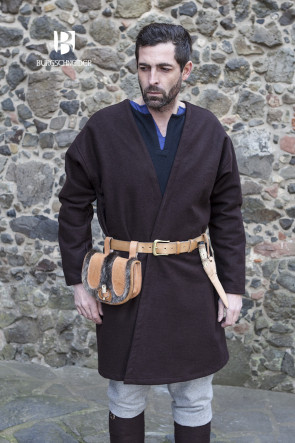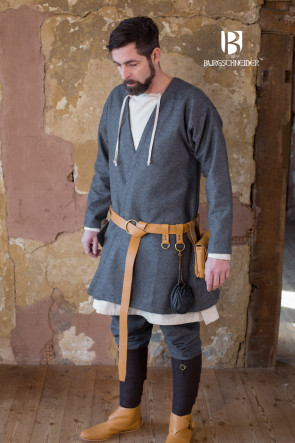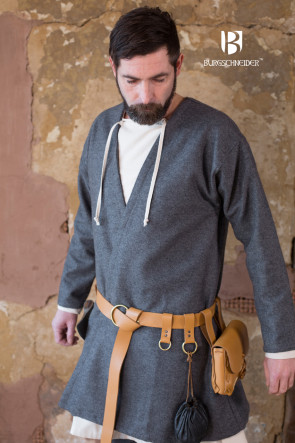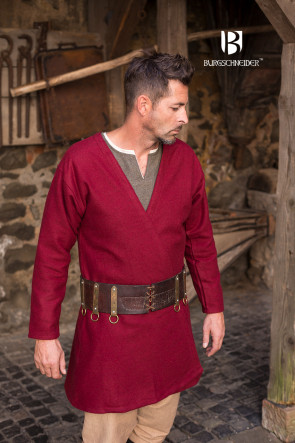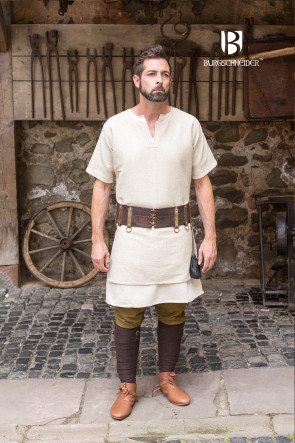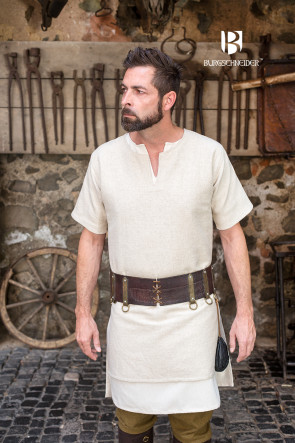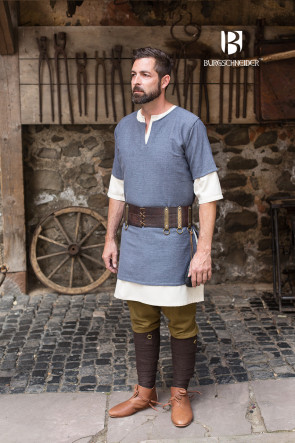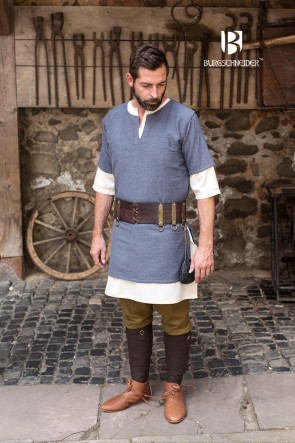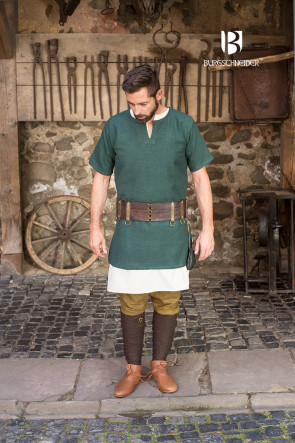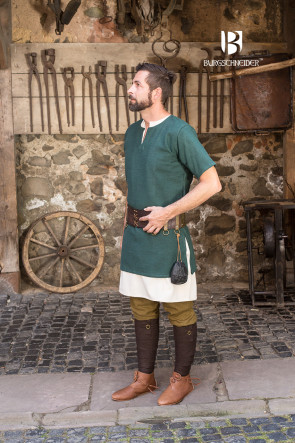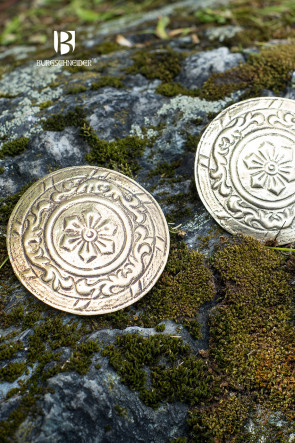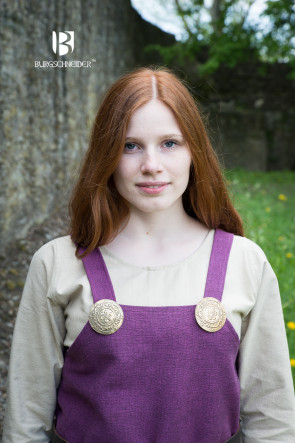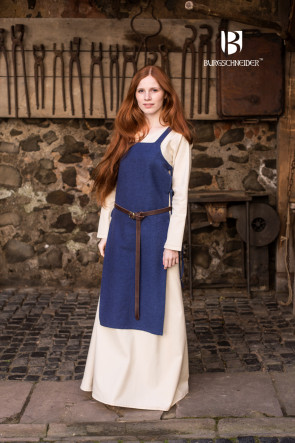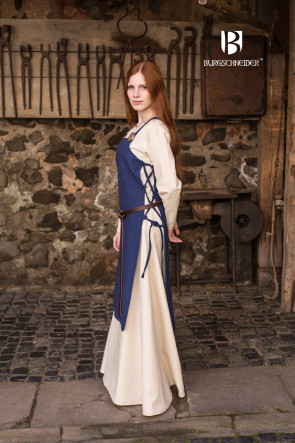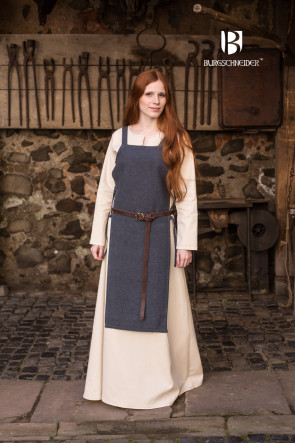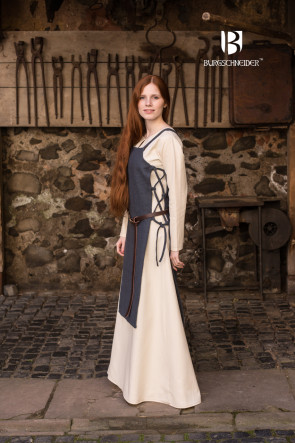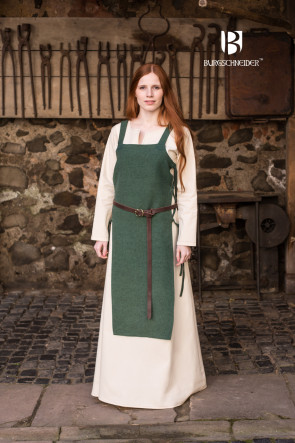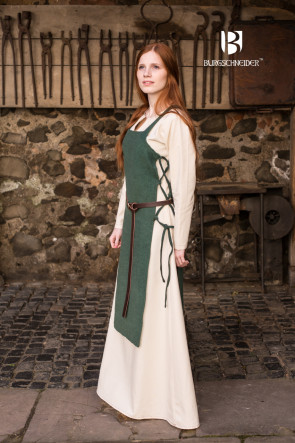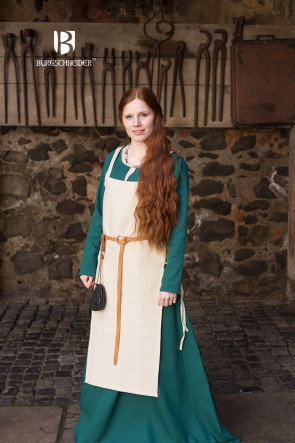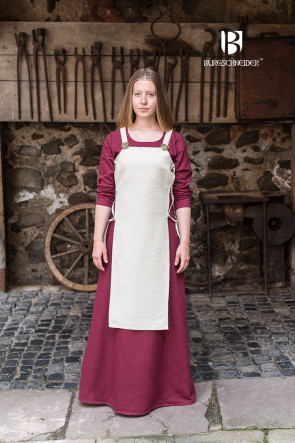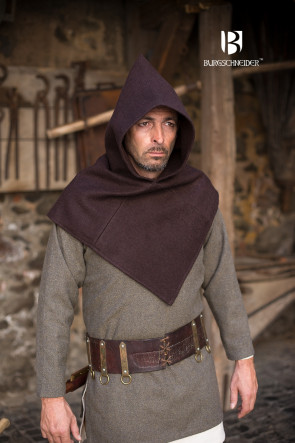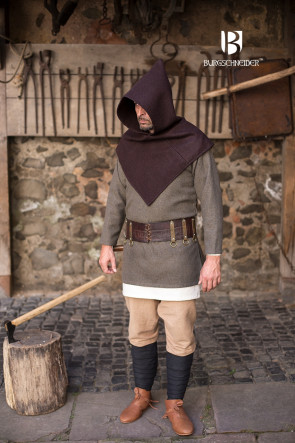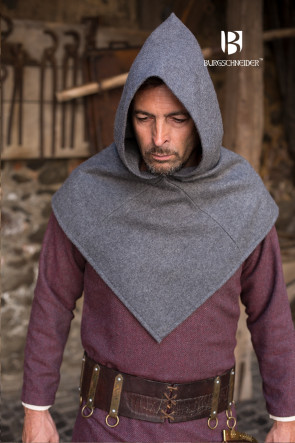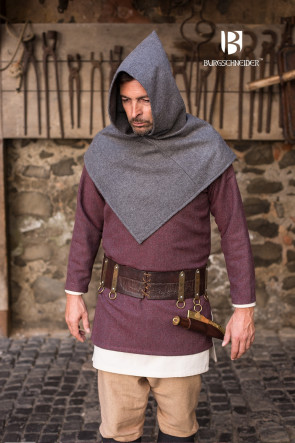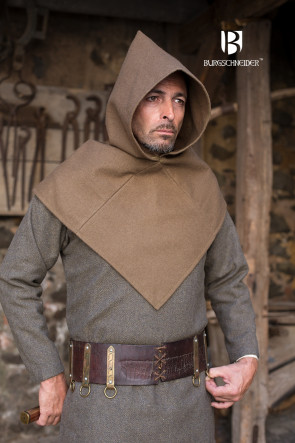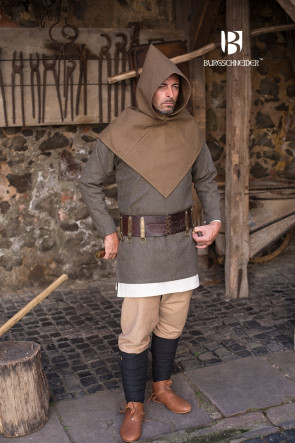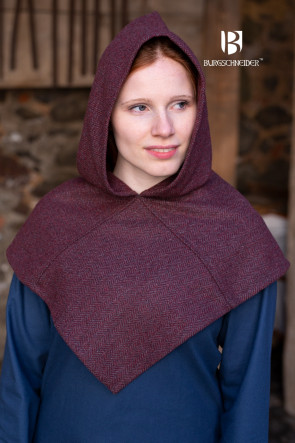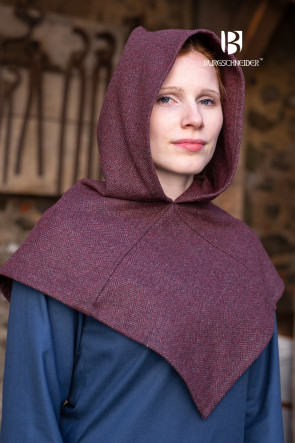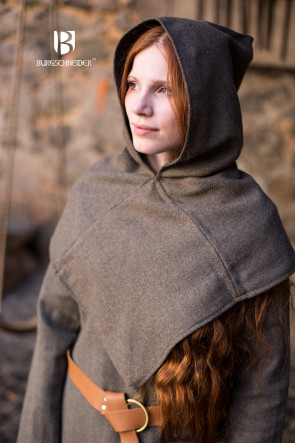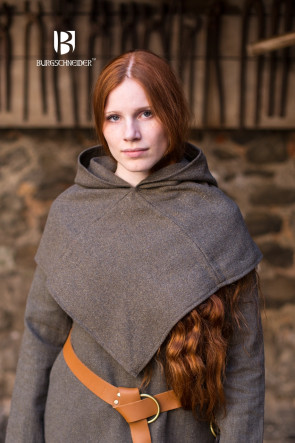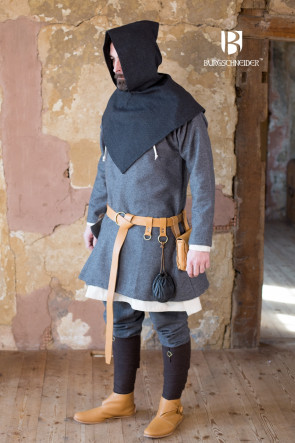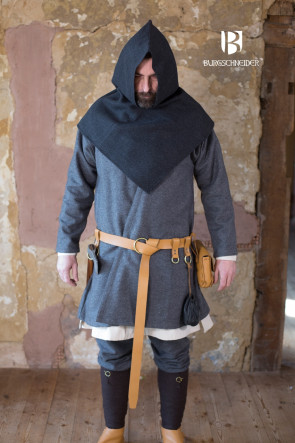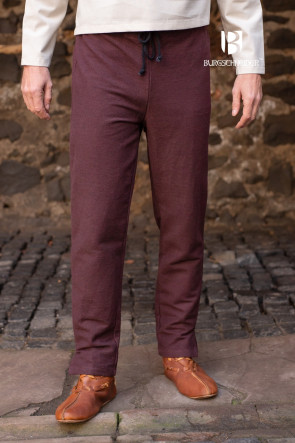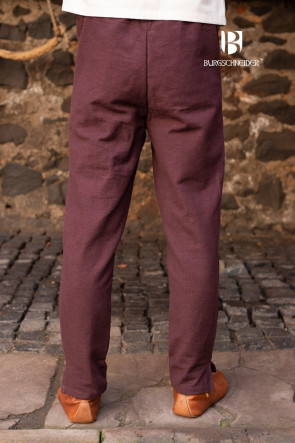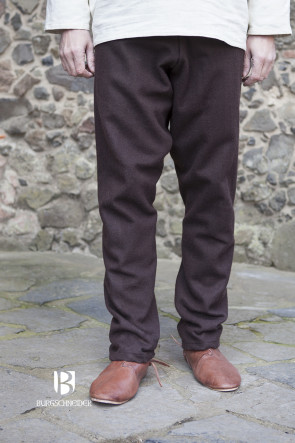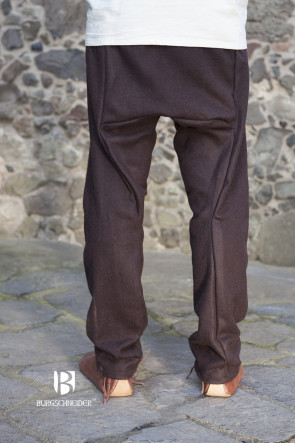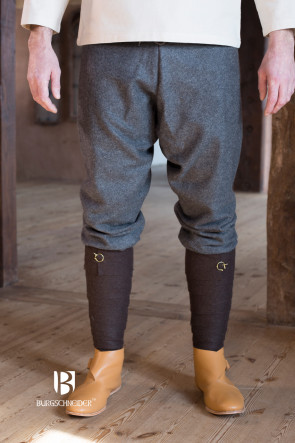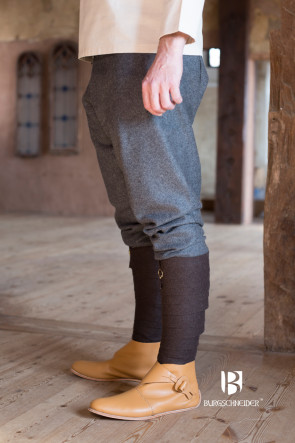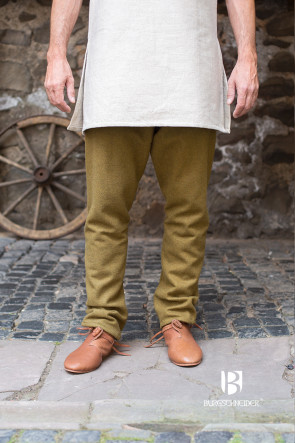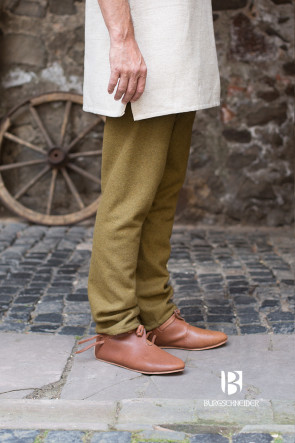Early Middle Ages ca. 500-1100
In general, the Middle Ages are divided into three epochs. The Early Middle Ages span the 6th to the 11th centuries and are, as the name implies, the first of these three epochs. During this time, fashion played a societal role completely different from what we are used to today. In the Early Middle Ages, clothing clearly depicted its wearer’s stratum. Strict laws codified which colors and items the lower strata were allowed to wear and which items were reserved for people with a higher station in life.
The clothing of the nobility and the peasants in the Early Middle Ages
Since the nobility in the Early Middle Ages considered their clothing a symbol of their status, they made it a point to have their garments fashioned only from the most exquisite materials. For instance, they preferred silk embroidered with golden or silver threads, so that everyone, at first glance, recognized that they stood before a member of the nobility.
Furthermore, the nobility wore long robes and dresses, whose cuts required vast amounts of fabric—because the more fabric one could display, the richer one was deemed. Those belonging to the lower strata couldn’t afford such luxury. For their clothing, they used materials that were readily available and regionally grown—such as linen or wool. Their garments had to be suitable for hard labor, so cuts and looks needed to be comfortable and practical instead.
Findings of clothing from the Early Middle Ages
Researching clothing of the Early Middle Ages is accomplished mainly by examining archeological findings, e.g., by excavating graves. Because in the Early Middle Ages clothes were usually made from organic materials, most original exemplars have long since fallen prey to natural decomposition.
Therefore, only very few items from this era have been found so far. In 1907 one reconstructable textile vestige was descried in a bog in Bernuthsfeld and recovered from a man’s grave there. As it turns out, that was the only bog corpse that has ever been found so far, and his clothes were exceptionally well preserved. He was dressed in an outer garment, which was patched up extensively and made from all kinds of different materials, as well as a large, blanket-like cloak.It is, however, fallacious to attempt to infer the wearer’s normal clothing from grave findings, for we cannot confirm whether these clothes were everyday garb or special burial garments.
-
25,13 €
-
25,13 €
-
Fibel Adil Groß
Our Big Brooch Adil Brass is a simple but handmade garment clasp, which can be used as a safety pin or (garment) brooch, of about 3.2 cm.
Mehr erfahren
Each brooch is unique, so small variations in shape and size are possible. Their simple elegance makes them suitable for any style.11,90 € -
Klappenrock Loki Wolle - Blau
- Material: Herringbone Wool Blend
- Genre: Historic
- Sizes: S - XXXL
- Reference: Klappenrock
69,90 € -
Klappenrock Loki Wolle - Braun
- Material: Herringbone Wool Blend
- Genre: Historic
- Sizes: S - XXXL
- Reference: Klappenrock
69,90 € -
Klappenrock Loki Wolle - Dunkelgrau
- Material: Herringbone Wool Blend
- Genre: Historic
- Sizes: S - XXXL
- Reference: Klappenrock
69,90 € -
Klappenrock Loki Wolle - Rot
- Material: Herringbone Wool Blend
- Genre: Historic
- Sizes: S - XXXL
- Reference: Klappenrock
69,90 € -
Kurzarmtunika Aegir - Hanf
- Material: 100% Cotton
- Genre: Historic
- Sizes: S - XXXL
- Reference: Bernuthsfeld Tunic
33,53 € -
Kurzarmtunika Aegir - Grau
- Material: 100% Cotton
- Genre: Historic
- Sizes: S - XXXL
- Reference: Bernuthsfeld Tunic
33,53 € -
Kurzarmtunika Aegir - Grün
- Material: 100% Cotton
- Genre: Historic
- Sizes: S - XXXL
- Reference: Bernuthsfeld Tunic
33,53 € -
Rundfibelset Ingwaz
Our two-piece round brooch set Ingwaz is handmade and can be used in many ways, e.g. individually, depending on the purpose. At the back is a clasp, similar to a safety pin. Each brooch has a diameter of about 5.5 cm.
Mehr erfahren
The floral pattern of the Viking-inspired disc brooch adorns any dress and can be attached to straps, as in the picture, but can also hold a coat together.25,13 € -
Schürzenkleid Gyda - Blau
- Material: 100% Cotton
- Genre: Historic
- Sizes: S - XXL
- Reference: Hedeby Dress
29,33 € -
Schürzenkleid Gyda - Grau
- Material: 100% Cotton
- Genre: Historic
- Sizes: S - XXL
- Reference: Hedeby Dress
29,33 € -
Schürzenkleid Gyda - Grün
- Material: 100% Cotton
- Genre: Historic
- Sizes: S - XXL
- Reference: Hedeby Dress
29,33 € -
Schürzenkleid Gyda - Hanf
- Material: 100% Cotton
- Genre: Historic
- Sizes: S - XXL
- Reference: Hedeby Dress
29,33 € -
Skjoldehamn Gugel Bjorn Wolle - Braun
The Skjoldehamn Cowl was discovered in a pagan grave from the first half of the 11th century. This is one of the first examples of the headgear "Gugel" itself.
The hood has a basic square shape, characteristically the wide brim ends with a corner on the chest.
The grave find from Skjoldehamn raised many questions since its recovery in 1936 and still occupies today. According to current research, the dating of the pagan grave in the marshland is the first half of the 11th century. The hood of the gugel from Skjoldehamn has a simple square basic shape and a very wide brim, which does not fall round, but with a corner on the chest. This gugel is also a very early example of the type of headgear that became a ubiquitous garment in Europe during the Middle Ages.
In the course of research, attempts were made to assign the garment to a gender and cultural group. For this purpose, not only the DNA of the buried person was examined more closely, but also the additional finds. The enclosed trousers determined the theory of the researchers that the person must have been male. DNA examination in 1999 showed no Y chromosome present in the bones, which supported the theory that it had to be a woman instead. However, this methodology is considered outdated.
The question of culture points to Norway. This is assumed by ornamentation and morphological features, which suggest that the buried person was a Sami tribal member. Further research is needed, as some key evidence for these hypotheses is still lacking. More modern DNA analysis and research into the history of the fashions of the various Sami groups will shed light on this.
Mehr erfahren25,13 € -
Skjoldehamn Gugel Bjorn Wolle - Grau
The Skjoldehamn Cowl was discovered in a pagan grave from the first half of the 11th century. This is one of the first examples of the headgear "Gugel" itself.
The hood has a basic square shape, characteristically the wide brim ends with a corner on the chest.
The grave find from Skjoldehamn raised many questions since its recovery in 1936 and still occupies today. According to current research, the dating of the pagan grave in the marshland is the first half of the 11th century. The hood of the gugel from Skjoldehamn has a simple square basic shape and a very wide brim, which does not fall round, but with a corner on the chest. This gugel is also a very early example of the type of headgear that became a ubiquitous garment in Europe during the Middle Ages.
In the course of research, attempts were made to assign the garment to a gender and cultural group. For this purpose, not only the DNA of the buried person was examined more closely, but also the additional finds. The enclosed trousers determined the theory of the researchers that the person must have been male. DNA examination in 1999 showed no Y chromosome present in the bones, which supported the theory that it had to be a woman instead. However, this methodology is considered outdated.
The question of culture points to Norway. This is assumed by ornamentation and morphological features, which suggest that the buried person was a Sami tribal member. Further research is needed, as some key evidence for these hypotheses is still lacking. More modern DNA analysis and research into the history of the fashions of the various Sami groups will shed light on this.
Mehr erfahren25,13 € -
Skjoldehamn Gugel Bjorn Wolle - Herbstgrün
The Skjoldehamn Cowl was discovered in a pagan grave from the first half of the 11th century. This is one of the first examples of the headgear "Gugel" itself.
The hood has a basic square shape, characteristically the wide brim ends with a corner on the chest.
The grave find from Skjoldehamn raised many questions since its recovery in 1936 and still occupies today. According to current research, the dating of the pagan grave in the marshland is the first half of the 11th century. The hood of the gugel from Skjoldehamn has a simple square basic shape and a very wide brim, which does not fall round, but with a corner on the chest. This gugel is also a very early example of the type of headgear that became a ubiquitous garment in Europe during the Middle Ages.
In the course of research, attempts were made to assign the garment to a gender and cultural group. For this purpose, not only the DNA of the buried person was examined more closely, but also the additional finds. The enclosed trousers determined the theory of the researchers that the person must have been male. DNA examination in 1999 showed no Y chromosome present in the bones, which supported the theory that it had to be a woman instead. However, this methodology is considered outdated.
The question of culture points to Norway. This is assumed by ornamentation and morphological features, which suggest that the buried person was a Sami tribal member. Further research is needed, as some key evidence for these hypotheses is still lacking. More modern DNA analysis and research into the history of the fashions of the various Sami groups will shed light on this.
Mehr erfahren25,13 € -
Skjoldehamn Gugel Knud Fischgrät - Bordeaux/Grau
The Skjoldehamn Cowl was discovered in a pagan grave from the first half of the 11th century. This is one of the first examples of the headgear "Gugel" itself.
Mehr erfahren
The hood has a basic square shape, characteristically the wide brim ends with a corner on the chest.
The grave find from Skjoldehamn raised many questions since its recovery in 1936 and still occupies today. According to current research, the dating of the pagan grave in the marshland is the first half of the 11th century. The hood of the gugel from Skjoldehamn has a simple square basic shape and a very wide brim which does not fall round but with a corner on the chest. This gugel is also a very early example of the type of headgear that became a ubiquitous garment in Europe during the Middle Ages.
In the course of research, attempts were made to assign the garment to a gender and cultural group. For this purpose, not only the DNA of the buried person was examined more closely but also the additional finds. The enclosed trousers determined the theory of the researchers that the person must have been male. DNA examination in 1999 showed no Y chromosome present in the bones which supported the theory that it had to be a woman instead. However, this methodology is considered outdated.
The question of culture points to Norway. This is assumed by ornamentation and morphological features which suggest that the buried person was a Sami tribal member. Further research is needed, as some key evidence for these hypotheses is still lacking. More modern DNA analysis and research into the history of the fashions of the various Sami groups will shed light on this.34,90 € -
Skjoldehamn Gugel Knud Fischgrät - Oliv/Grau
The Skjoldehamn Cowl was discovered in a pagan grave from the first half of the 11th century. This is one of the first examples of the headgear "Gugel" itself.
Mehr erfahren
The hood has a basic square shape, characteristically the wide brim ends with a corner on the chest.
The grave find from Skjoldehamn raised many questions since its recovery in 1936 and still occupies today. According to current research, the dating of the pagan grave in the marshland is the first half of the 11th century. The hood of the gugel from Skjoldehamn has a simple square basic shape and a very wide brim which does not fall round but with a corner on the chest. This gugel is also a very early example of the type of headgear that became a ubiquitous garment in Europe during the Middle Ages.
In the course of research, attempts were made to assign the garment to a gender and cultural group. For this purpose, not only the DNA of the buried person was examined more closely but also the additional finds. The enclosed trousers determined the theory of the researchers that the person must have been male. DNA examination in 1999 showed no Y chromosome present in the bones which supported the theory that it had to be a woman instead. However, this methodology is considered outdated.
The question of culture points to Norway. This is assumed by ornamentation and morphological features which suggest that the buried person was a Sami tribal member. Further research is needed, as some key evidence for these hypotheses is still lacking. More modern DNA analysis and research into the history of the fashions of the various Sami groups will shed light on this.34,90 € -
Skjoldehamn Gugel Knud Fischgrät - Schwarz/Grau
The Skjoldehamn Cowl was discovered in a pagan grave from the first half of the 11th century. This is one of the first examples of the headgear "Gugel" itself.
Mehr erfahren
The hood has a basic square shape, characteristically the wide brim ends with a corner on the chest.
The grave find from Skjoldehamn raised many questions since its recovery in 1936 and still occupies today. According to current research, the dating of the pagan grave in the marshland is the first half of the 11th century. The hood of the gugel from Skjoldehamn has a simple square basic shape and a very wide brim which does not fall round but with a corner on the chest. This gugel is also a very early example of the type of headgear that became a ubiquitous garment in Europe during the Middle Ages.
In the course of research, attempts were made to assign the garment to a gender and cultural group. For this purpose, not only the DNA of the buried person was examined more closely but also the additional finds. The enclosed trousers determined the theory of the researchers that the person must have been male. DNA examination in 1999 showed no Y chromosome present in the bones which supported the theory that it had to be a woman instead. However, this methodology is considered outdated.
The question of culture points to Norway. This is assumed by ornamentation and morphological features which suggest that the buried person was a Sami tribal member. Further research is needed, as some key evidence for these hypotheses is still lacking. More modern DNA analysis and research into the history of the fashions of the various Sami groups will shed light on this.34,90 € -
Skjoldehamn Hose Gunnar - Braun
The Gunnar Skjoldehamn Trousers are practical, extremely versatile and easily compliment a huge variety of historical or fantasy characters. The trousers are made of a wool blend and can complement just about any shirt or tunic for an authentic medieval look. Slits along the cuffs allow them to fit over all kinds of boots and shoes. A drawstring and ribbon at the waistband allow the trousers to be fastened tightly without needing a belt. It’s the perfect choice for a low maintenance costume!
Mehr erfahren33,53 € -
Thorsberghose Fenris - Wolle Braun
- Material: Wool Blend
- Genre: Historic
- Sizes: S - XXXL
- Reference: Thorsberg Trousers
41,93 € -
Thorsberghose Fenris - Wolle Dunkelgrau
- Material: Wool Blend
- Genre: Historic
- Sizes: S - XXXL
- Reference: Thorsberg Trousers
41,93 € -
Thorsberghose Fenris - Wolle Herbstgrün
- Material: Wool Blend
- Genre: Historic
- Sizes: S - XXXL
- Reference: Thorsberg Trousers
41,93 €








